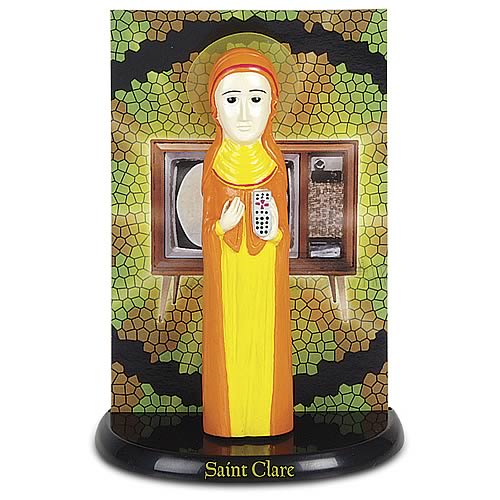Why St. Clare? Pope Pius XII's Surprising Choice For TV Patron Saint
Why would a 13th-century Franciscan foundress, steeped in evangelical poverty and far removed from the technological marvels of the 20th century, be named the patron saint of television? The answer lies in the profound spiritual experiences of Saint Clare of Assisi and the innovative thinking of Pope Pius XII, a combination that connected faith and the burgeoning world of broadcast media in a truly unique way.
The story begins with the advent of television. By the late 1950s, it was clear that this new form of media was poised to transform modern society, permeating homes and influencing how people consumed information and entertainment. Pope Pius XII, recognizing the profound impact of this new technology, sought to provide both the Church's blessing and spiritual guidance for this emerging medium. His decision led him to a remarkable choice: Saint Clare of Assisi, a woman who lived centuries before the invention of television.
| Attribute | Details |
|---|---|
| Full Name | Clare Offreduccio |
| Born | July 16, 1194, Assisi, Italy |
| Died | August 11, 1253, Assisi, Italy |
| Feast Day | August 11th |
| Founder of | The Order of Poor Ladies (Poor Clares) |
| Patronage | Television, eye disease, good weather, goldsmiths, embroiderers, laundry workers |
| Beatified | 1253 by Pope Innocent IV |
| Canonized | 1255 by Pope Alexander IV |
| Key Achievements | Founder of the Poor Clares, a monastic order dedicated to poverty; influential spiritual leader; known for her devotion to the Eucharist and her mystical experiences. |
| Significant Writings | Letters to Agnes of Prague; Rule of Saint Clare. |
| Connection to Television | Pope Pius XII declared her the patron saint of television in 1958 due to her reported ability to "see" and "hear" Mass from her room when she was too ill to attend. |
| Reference | Encyclopaedia Britannica |
To understand this unusual patronage, one must delve into the life of Saint Clare. Born in Assisi, Italy, in 1194, Clare was deeply influenced by the preaching of Saint Francis of Assisi. Drawn to a life of radical poverty and devotion to God, she founded the Order of Poor Ladies, later known as the Poor Clares. This order was dedicated to emulating the poverty of Christ, living a life of simplicity and service. Clare's dedication to her faith and her commitment to a life of spiritual contemplation set the stage for her connection to the world of television, centuries later.
- My Tutor 1983 Nude Scenes Where To Watch More
- Find Movies Like The Ballad Of Buster Scruggs Start Here
The crucial event that cemented her place in television history occurred when Clare was ill. Unable to attend Mass, she was reportedly able to visualize and hear the service as if it were being projected directly onto the wall of her room. This miraculous experience, this "vision from afar" as it were, is the crux of the story. It was this capacity for seeing and hearing events from a distance that resonated with Pope Pius XII when he sought a patron saint for the nascent technology of television.
Pope Pius XII's decree wasn't a rash decision. He was a scholar, a man of deep faith, and keenly aware of the power of communication. He recognized that television, despite its technological advancements, could also be a powerful tool for the spread of information, education, and spiritual messages. He understood the need for a spiritual figure to guide its use and provide protection for its viewers and those who worked within the industry.
The designation of Saint Clare as the patron saint of television was officially proclaimed in the Apostolic Letter, issued in February of 1958, though the process had started earlier. The papal decree did not just honor St. Clare; it also sought to imbue the new medium with a spiritual dimension, underscoring the responsibility of those using television to uphold ethical standards and promote values that were aligned with the Church's teachings.
- Brian Williams Salary Net Worth A Closer Look
- Discover Iconic Canadian Female Singers In Music History
The choice of Saint Clare was multifaceted. First, there was the "vision from afar" incident. This mystical experience, where Clare could perceive events taking place elsewhere, provided a striking parallel to the ability of television to transmit images and sounds across distances. The connection was immediate and potent. Secondly, Clare's life of poverty, humility, and unwavering love for the Lord represented the virtues that Pope Pius XII wished to promote in the use of this new technology. The Pope saw in Clare a model of spiritual purity, a beacon to guide viewers and media professionals alike.
Additionally, the Pope's decision was a strategic move. It was a way to integrate television into the life of the Church and to influence the content that was broadcast. By placing television under the patronage of a saint, the Vatican expressed its interest in the technology and provided a framework for its moral and spiritual considerations. The move was also aimed at making television a source of spiritual and moral guidance.
The naming of St. Clare as the patron saint of television highlights the enduring relevance of faith in the face of technological advancement. It is a testament to the Church's ability to adapt and find meaning in the modern world. The story of Saint Clare and television serves as a reminder that technology, while powerful, should always be guided by ethical considerations and spiritual values. It is a call for media professionals to be responsible and for viewers to watch with discernment.
The legacy of Saint Clare as the patron saint of television continues to resonate today. In an age where television and streaming services continue to shape our culture, her example is more important than ever. It is a reminder that we must approach media with a critical eye, seeking out content that uplifts, inspires, and promotes the common good.
Beyond her patronage of television, Saint Clare's life continues to inspire. She is also the patron saint of eye diseases, good weather, and goldsmiths and embroiderers, reflecting the diverse areas of life she touched. Her feast day, celebrated on August 11th, is a time to reflect on her teachings and to pray for her intercession.
The story of Saint Clare and television is more than just a historical curiosity. It's a powerful illustration of the intersection of faith and technology. It demonstrates the Church's willingness to embrace new forms of communication and to infuse them with spiritual meaning. The choice of Saint Clare, who could "see" the Mass from afar, offered a perfect symbolic resonance to a medium which could show events happening thousands of miles away. As we continue to navigate the ever-evolving landscape of media, we can look to Saint Clare as a source of inspiration, reminding us to use technology responsibly and to strive for the values of faith, humility, and love in everything we do.
The Apostolic Letter issued by Pope Pius XII in 1958 was not the only instance where the Catholic Church acknowledged the impact of technology. In 1951, the Pope designated the Archangel Gabriel, one of the seven angels who "stand before God," as the patron saint of telecommunications and television workers. Previously, the Archangel Gabriel had been designated by a papal brief as patron of postal employees, reflecting the importance of communication in both the spiritual and secular spheres.
The selection of St. Clare also highlights the importance of spiritual communion. St. Clare, by experiencing the Mass in her room, made an act of spiritual communion. This connection between her and the Mass demonstrated the ability to participate in something bigger and more impactful, even from afar. The Church sees communion in all forms, and in this situation it was the ability to have a "shared" experience despite physical limitations.
The link between Saint Clare and television also underscores the power of faith. The fact that the Church acknowledged that she had experienced a vision which had a correlation with modern television shows that faith and technology are not mutually exclusive. Rather, that technology can, potentially, enhance or provide another avenue for faith. It underscores the idea that the Church seeks to engage with modernity and see how it can fit in with the faith.
In conclusion, the story of Saint Clare as the patron saint of television is a unique and fascinating chapter in the history of the Catholic Church. It speaks to the foresight of Pope Pius XII, the profound spirituality of Saint Clare, and the evolving relationship between faith and technology. It is a story that continues to resonate today, reminding us to approach media with discernment, humility, and a commitment to the values of the Gospel.



Detail Author:
- Name : Mr. Eloy Von
- Username : vheathcote
- Email : blaise44@kemmer.com
- Birthdate : 1993-11-17
- Address : 160 Mertz Field East Lethamouth, MN 34046
- Phone : +1-364-445-7984
- Company : Ortiz, Harvey and Wiegand
- Job : Nutritionist
- Bio : Et excepturi repellendus eum consequatur velit similique exercitationem nobis. Ut et earum rem ut voluptates. Ut eveniet quidem modi et odio eos velit. Ut sint quia adipisci.
Socials
linkedin:
- url : https://linkedin.com/in/ken_flatley
- username : ken_flatley
- bio : Asperiores fuga doloremque sunt veritatis.
- followers : 142
- following : 2782
instagram:
- url : https://instagram.com/flatleyk
- username : flatleyk
- bio : Rem eos et et possimus mollitia omnis. Unde beatae quibusdam nemo iure sequi. Rerum id quisquam ab.
- followers : 3037
- following : 233
tiktok:
- url : https://tiktok.com/@flatleyk
- username : flatleyk
- bio : Libero sed assumenda consectetur voluptatem voluptatem minima omnis.
- followers : 6164
- following : 1490
twitter:
- url : https://twitter.com/flatleyk
- username : flatleyk
- bio : Ea quo iste adipisci et aut quidem velit. Cum similique et vel vel. In natus necessitatibus iste eum nesciunt ut et. Dolores quia incidunt sit libero.
- followers : 2005
- following : 2196